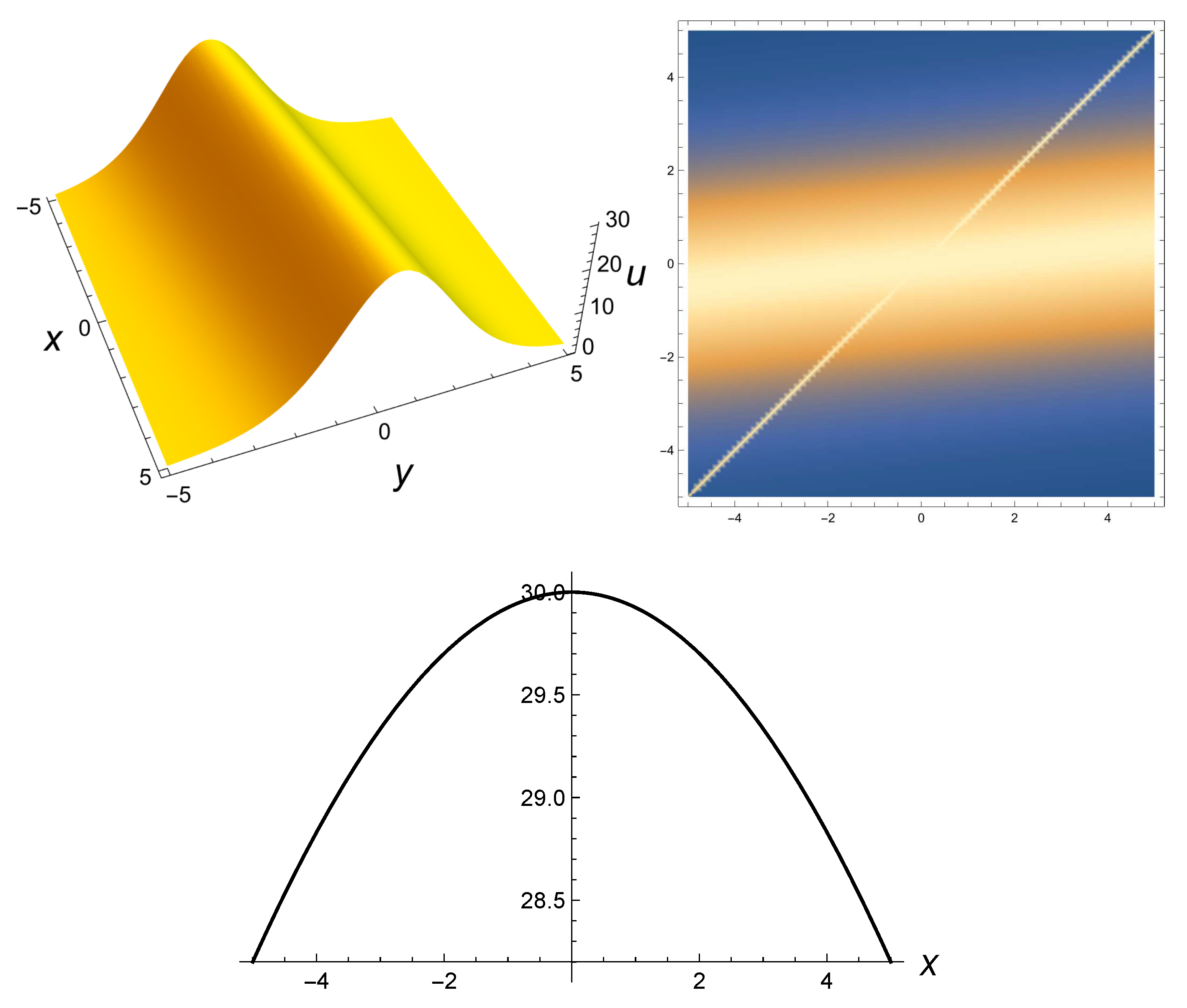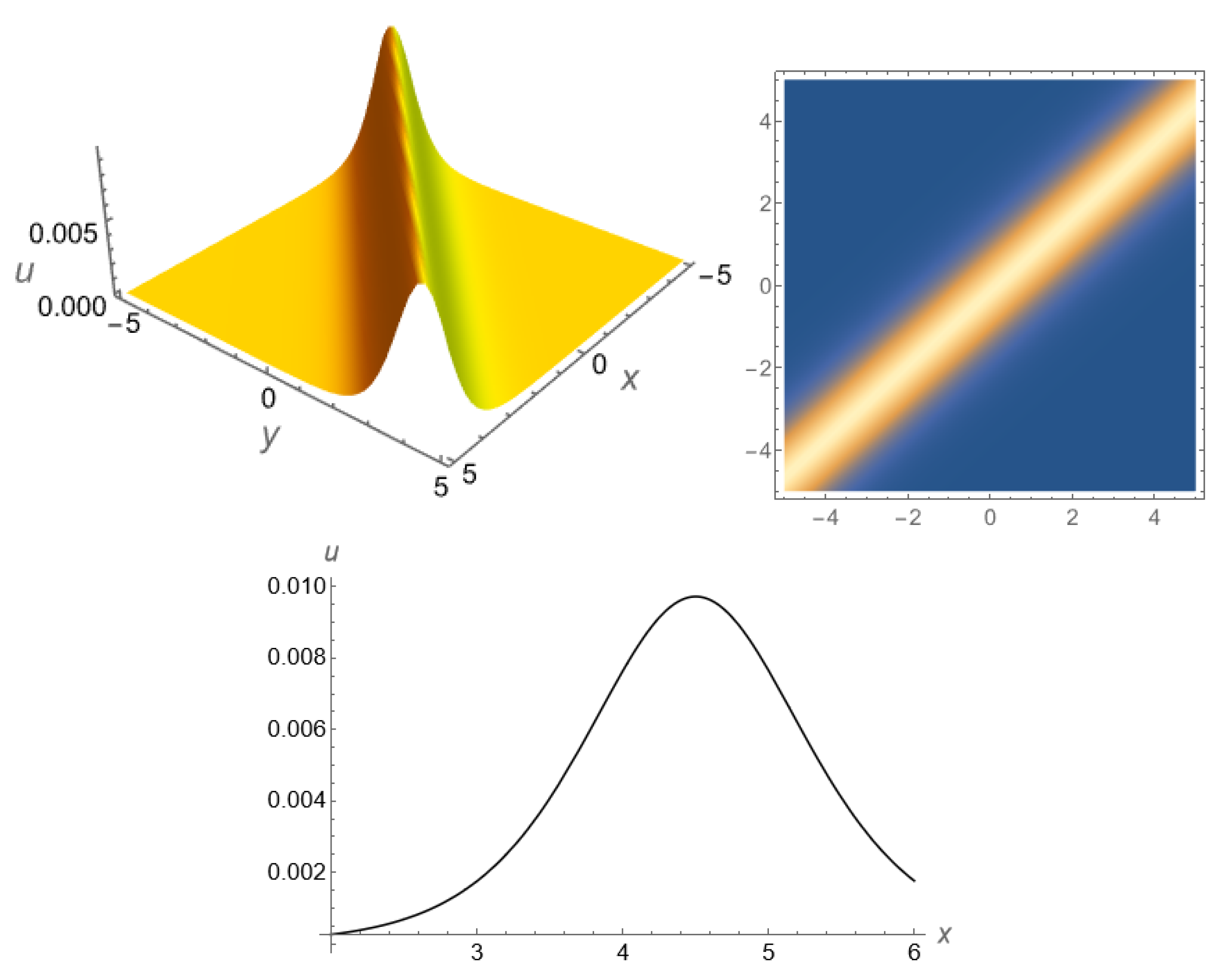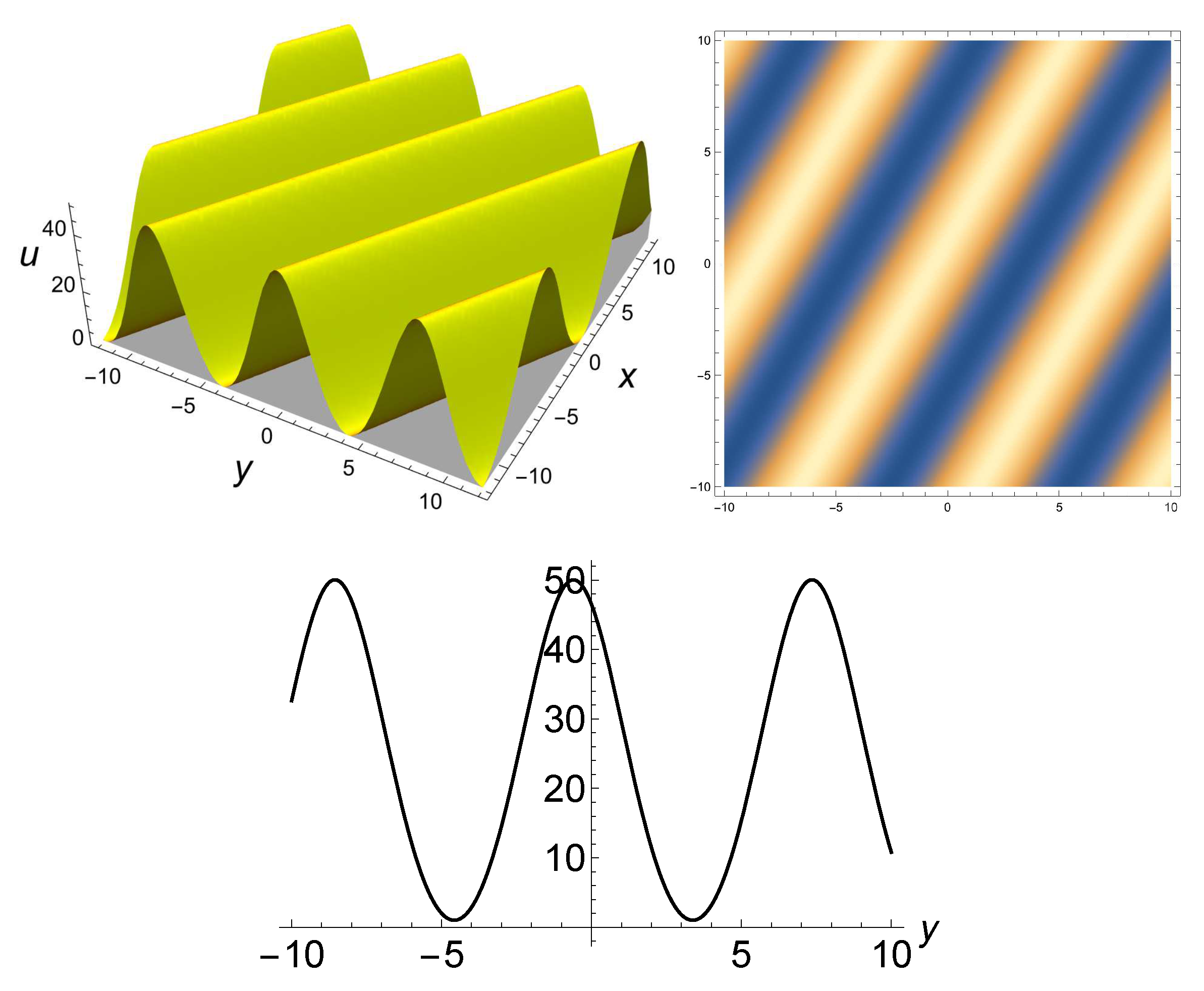Symmetry Methods and Conservation Laws for the Nonlinear Generalized 2D Equal-Width Partial Differential Equation of Engineering
Abstract
:1. Introduction
2. Symmetries, Reductions and Solutions
2.1. Lie Symmetries
2.2. Symmetry Reductions Using
2.3. Solution of (6) Using Kudryashov’s Method
2.4. Solitary Wave Solution of (6)
2.5. Solutions of (6) for
2.5.1. Solution via Direct Integration
2.5.2. Solution via Weierstrass Elliptic Function Method
2.5.3. Solution via the Extended Jacobi Elliptic Function Method
2.6. Solution of (6) for Using
3. Conservation Laws
3.1. Conservation Laws Using the Multiplier Method
3.2. Conservation Laws Using Noether’s Theorem
4. Conclusions
Author Contributions
Funding
Institutional Review Board Statement
Informed Consent Statement
Data Availability Statement
Acknowledgments
Conflicts of Interest
References
- Xu, G.; Zhang, Y.; Li, J. Exact solitary wave and periodic-peakon solutions of the complex Ginzburg-Landau equation: Dynamical system approach. Math. Comput. Simul. 2022, 191, 157–167. [Google Scholar] [CrossRef]
- Mahak, N.; Akram, G. Exact solitary wave solutions of the (1+1)-dimensionional Fokas-Lenells equation. Optik 2020, 208, 164459. [Google Scholar] [CrossRef]
- Patsiuk, O.; Kovalenko, S. Symmetry reduction and exact solutions of the non-linear Black-Scholes equation. Commun. Nonliear Sci. Numer. Simulat. 2018, 62, 164–173. [Google Scholar] [CrossRef] [Green Version]
- Celik, N.; Seadawy, A.R.; Ozkan, Y.S.; Yasar, E. A model of solitary waves in a nonlinear elastic circular rod: Abundant different type of exact solutions and conservation laws. Chaos Solit. Fractals 2021, 143, 110486. [Google Scholar] [CrossRef]
- Rogers, C.; Shadwick, W.F. Bäcklund Transformations and Their Applications; Mathematics in Science and Engineering Series; Academic Press: New York, NY, USA, 1982. [Google Scholar]
- Krasil’shchik, I.S.; Vinogradov Editors, A.M. Symmetries and Conservation Laws for Differential Equations of Mathematical Physics; American Mathematical Society: Providence, RI, USA, 1999. [Google Scholar]
- Igonin, S.; Van De Leur, J.; Manno, G.; Trushko, V. Infinite-dimensional prolongation Lie algebras and multicomponent Landau-Lifshitz systems associated with higher genus curves. J. Geom. Phys. 2013, 68, 1–26. [Google Scholar] [CrossRef] [Green Version]
- Kudryashov, N.A. Simplest equation method to look for exact solutions of nonlinear differential equations. Chaos Solit. Fractals 2005, 24, 1217–1231. [Google Scholar] [CrossRef] [Green Version]
- Wen, X.; Lu, D. Extended Jacobi elliptic function expansion method and its application to nonlinear evolution equation. Chaos Solit. Fractals 2009, 41, 1454–1458. [Google Scholar] [CrossRef]
- Liu, H.; Sang, B.; Xin, X.; Liu, X. CK transformations, symmetries, exact solutions and conservation laws of the generalized variable-coefficient KdV types of equations. J. Comput. Appl. Math. 2019, 345, 127–134. [Google Scholar] [CrossRef]
- Malfliet, W. Solitary wave solutions of nonlinear wave equations. Am. J. Phys. 1992, 60, 650. [Google Scholar] [CrossRef]
- Ovsiannikov, L.V. Group Analysis of Differential Equations; Academic Press: New York, NY, USA, 1982. [Google Scholar]
- Bluman, G.W.; Kumei, S. Symmetries and Differential Equations; Springer: New York, NY, USA, 1989. [Google Scholar]
- Olver, P.J. Applications of Lie Groups to Differential Equations, 2nd ed.; Springer: Berilin/Heidelberg, Germany, 1993. [Google Scholar]
- Ibragimov, N.H. CRC Handbook of Lie Group Analysis of Differential Equations; CRC Press: Boca Raton, FL, USA, 1995; Volume 2. [Google Scholar]
- Ibragimov, N.H. Elementary Lie Group Analysis and Ordinary Differential Equations; John Wiley & Sons: Chichester, NY, USA, 1999. [Google Scholar]
- Khalique, C.M.; Plaatjie, K. Exact solutions and conserved vectors of the two-dimensional generalized shallow water wave equation. Mathematics 2021, 9, 1439. [Google Scholar] [CrossRef]
- Adeyemo, O.D.; Motsepa, T.; Khalique, C.M. A study of the generalized nonlinear advection diffusion equation arising in engineering sciences. Alexandria Eng. J. 2022, 61, 185–194. [Google Scholar] [CrossRef]
- Zhang, L.; Khalique, C.M. Classification and bifurcation of a class of second-order ODEs and its application to nonlinear PDEs. Discrete Cont. Dyn-S 2018, 11, 777–790. [Google Scholar] [CrossRef]
- Wang, M.; Li, X.; Zhang, J. The (G′/G)−expansion method and travelling wave solutions for linear evolution equations in mathematical physics. Phys. Lett. A 2005, 24, 1257–1268. [Google Scholar]
- Leveque, R.J. Numerical Methods for Conservation Laws, 2nd ed.; Birkhäuser-Verlag: Basel, Switzerland, 1992. [Google Scholar]
- Sjöberg, A. On double reductions from symmetries and conservation laws. Nonlinear Anal. Real World Appl. 2009, 10, 3472–3477. [Google Scholar] [CrossRef]
- Noether, E. Invariante variationsprobleme. Nachrichten von der Gesellschaft der Wissenschaften zu Göttingen 1918, 2, 235–257. [Google Scholar]
- Sarlet, W. Comment on ‘Conservation laws of higher order nonlinear PDEs and the variational conservation laws in the class with mixed derivatives’. J. Phys. A Math. Theor. 2010, 43, 458001. [Google Scholar] [CrossRef]
- Khalique, C.M.; Abdallah, S.A. Coupled Burgers equations governing polydispersive sedimentation; a Lie symmetry approach. Results Phys. 2020, 16, 102967. [Google Scholar] [CrossRef]
- Khalique, C.M.; Maefo, K. A study on the (2+1)-dimensional first extended Calegero-Bogoyavlenskii-Schiff equation. Math. Bioci. Eng. 2021, 18, 5816–5835. [Google Scholar] [CrossRef] [PubMed]
- Gandarias, M.L.; Duran, M.R.; Khalique, C.M. Conservation laws and travelling wave solutions for double dispersion equations in (1+1) and (2+1) dimensions. Symmetry 2020, 12, 950. [Google Scholar] [CrossRef]
- Ibragimov, N.H. A new conservation theorem. J. Math. Anal. Appl. 2007, 333, 311–328. [Google Scholar] [CrossRef] [Green Version]
- Naz, R.; Mahomed, F.M.; Mason, D.P. Conservation laws via the partial Lagrangian and group invariant solutions for radial and two-dimensional free jets. Nonlinear. Anal. Real World Appl. 2009, 10, 3457–3465. [Google Scholar] [CrossRef]
- Motsepa, T.; Khalique, C.M. Closed-form solutions and conserved vectors of the (3+1)-dimensional negative-order KdV equation. Adv. Math. Models Appl. 2020, 5, 7–18. [Google Scholar]
- Jhangeer, A.; Naeem, I. Conserved quantities for a class of (1+n)-dimensional linear evolution equation. Commun. Nonlinear Sci. Numer. Simul. 2012, 17, 2804–2814. [Google Scholar] [CrossRef]
- Morrison, P.J.; Meiss, J.D.; Carey, J.R. Scattering of regularized long-waves. Phys. D 1984, 11, 324–336. [Google Scholar] [CrossRef]
- Khalique, C.M.; Plaatjie, K.; Simbanefayi, I. Exact solutions of equal-width equation and its conservation laws. Open Phys. 2019, 17, 505–511. [Google Scholar] [CrossRef]
- Gardner, L.R.T.; Gardner, G.A.; Ayoub, F.A.; Amein, N.K. Simulations of the EW undular bore. Comput. Num. Methods Engrg. 1997, 13, 583–592. [Google Scholar] [CrossRef]
- Lu, D.; Seadawy, A.R.; Ali, A. Dispersive traveling wave solutions of the equal-width and modified equal-width equations via mathematical methods and its applications. Results Phys. 2018, 9, 313–320. [Google Scholar] [CrossRef]
- Zaki, S.I. Solitary wave interactions for the modified equal width equation. Comput. Phys. Commun. 2000, 126, 219–231. [Google Scholar] [CrossRef]
- Saka, B. Algorithms for numerical solution of the modified equal width wave equation using collocation method. Math. Comput. Model 2007, 45, 1096–1117. [Google Scholar] [CrossRef]
- Khalique, C.M.; Adeyemo, O.D.; Simbanefayi, I. On optimal system, exact solutions and conservation laws of the modified equal-width equation. Appl. Mathe. Nonlinear Sci. 2018, 3, 409–418. [Google Scholar] [CrossRef] [Green Version]
- Hamdi, S.; Enright, W.H.; Schiesser, W.E.; Gottlieb, J.J. Exact solutions of the generalized equal width wave equation. In Computational Science and Its Applications—ICCSA 2003; Lecture Notes in Computer Science; Kumar, V., Gavrilova, M.L., Tan, C.J.K., L’Ecuyer, P., Eds.; Springer: Berlin/Heidelberg, Germany, 2003; Volume 2668. [Google Scholar]
- Munir, M.; Athar, M.; Sarwar, S.; Shatanawi, W. Lie symmetries of generalized equal width wave equations. AIMS Math. 2021, 6, 12148–12165. [Google Scholar] [CrossRef]
- Padmasekaran, S.; Asokan, R.; Kannagidevi, K. Lie symmetries of (2+1)-dimensional modified equal width wave equation. Int. J. Math. Trends Technol. 2018, 56, 2231–5373. [Google Scholar]
- Kudryashov, N.A. One method for finding exact solutions of nonlinear differential equations. Commun. Nonlinear Sci. Numer. Simulat. 2012, 17, 2248–2253. [Google Scholar] [CrossRef] [Green Version]
- Kudryashov, N.A. Analytical Theory of Nonlinear Differential Equations; Institute of Computer Investigations: Moskow, Russia, 2004.
- Abramowitz, M.; Stegun, I. Handbook of Mathematical Functions; Dover: New York, NY, USA, 1972. [Google Scholar]
- Kudryashov, N.A. First integrals and general solution of the Fokas-Lenells equation. Optik 2019, 195, 163135. [Google Scholar] [CrossRef]




Publisher’s Note: MDPI stays neutral with regard to jurisdictional claims in published maps and institutional affiliations. |
© 2021 by the authors. Licensee MDPI, Basel, Switzerland. This article is an open access article distributed under the terms and conditions of the Creative Commons Attribution (CC BY) license (https://creativecommons.org/licenses/by/4.0/).
Share and Cite
Khalique, C.M.; Plaatjie, K. Symmetry Methods and Conservation Laws for the Nonlinear Generalized 2D Equal-Width Partial Differential Equation of Engineering. Mathematics 2022, 10, 24. https://doi.org/10.3390/math10010024
Khalique CM, Plaatjie K. Symmetry Methods and Conservation Laws for the Nonlinear Generalized 2D Equal-Width Partial Differential Equation of Engineering. Mathematics. 2022; 10(1):24. https://doi.org/10.3390/math10010024
Chicago/Turabian StyleKhalique, Chaudry Masood, and Karabo Plaatjie. 2022. "Symmetry Methods and Conservation Laws for the Nonlinear Generalized 2D Equal-Width Partial Differential Equation of Engineering" Mathematics 10, no. 1: 24. https://doi.org/10.3390/math10010024
APA StyleKhalique, C. M., & Plaatjie, K. (2022). Symmetry Methods and Conservation Laws for the Nonlinear Generalized 2D Equal-Width Partial Differential Equation of Engineering. Mathematics, 10(1), 24. https://doi.org/10.3390/math10010024






